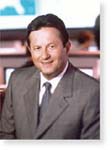Convergence –a buzzword much employed in certain circles – is a lot like the weather: Everybody’s talking about it, no one can control it and how you prepare for it depends on where you are. Engineers view it as the challenge of routing web content and e-mail into cellular phones, handheld computers and pagers. Brand managers and marketers see convergence as the merging of formerly distinct disciplines such as television, print media and commercials blending into a single stream. Example: Sports Illustrated magazine reporters working on CNN, both of which are now subsidiaries of a new hybrid “network” called America Online. Beyond these perspectives are complexities of consumer loyalties and behavioral issues. One survey has found that one in four families is watching television at the same time they are surfing the Internet. Which is their top priority? That question and more came up at the inaugural session of the
“We’re faced with having to integrate disparate types of information in a rapidly closing technology environment,” said Nacchio. He pointed out that convergence poses a dual dilemma: Figuring out how fast technology is moving, and answering questions such as ‘What are people really going to use and what are they really going to buy?’ “Very few people have experienced the true convergence of voice, data and video,” Nacchio said.
Morris, who heads Yack.com, an online guide to 700,000 hours of streaming media available daily on the Web, provided a measure of convergence success. When his company directs people from one medium to another and back again, he considers that a sign of things coming together.
In the early days of direct broadcast satellite programming, people who bought their home satellite dishes expected to see thousands of programs for free. It took four years for the industry to encrypt the content to thwart cable TV pirates, Morris said. That model is being repeated today, as Internet connection speeds have increased and equipment prices have fallen. The basic content costs have declined in tandem, so that premium content and higher-speed delivery are the only revenue sources left.
“No one can make it on a single revenue stream anymore. But four or five years ago convergence was defined differently. People called it interactive television,” Morris added.
The lines between work and home have blurred, with some expectations that the computer “desktop” idiom of the 1980s will soon give way to a game or virtual reality interface more familiar to a younger generation. In time, work tasks and documents will look more like magazines, TV programs and familiar “media” that have previously been vehicles for entertainment, predicted Siebel Systems’ Zoldan.
Instead of computing systems that tied co-workers together more closely, the next revolution will be in bringing consumers closer to the companies that serve them. Companies already are grappling with questions of how much personal data consumers are willing to divulge in return for more personalized, responsive service.
Predictably, there will be users who refuse to converge, or who see little value in the convergence of different appliances and media. Jagadeesh of Netscaler, a company that caches Internet content for faster delivery, represented that point of view. “I don’t want to sit in my family room and read E-mail on the TV. That’s a private communication,” said Jagadeesh. “And people don’t feel comfortable watching multi-media on a PC.”
Interestingly, the term “programming” has come to mean exactly the same thing in once separate industries, said Banister, founder of Windsor Digital, a next-generation entertainment company. The word was used by computer engineers to identify the functions and code that allowed users to perform specific tasks. In television, radio and films, the same word defined the content or programs that filled the schedules and airwaves. Now they both refer to the content that’s needed to support hardware.
Banister has worked in television and film production, multimedia and the online site Entertaindom.com. He sees a continuation of the endless cycle of bandwidth constraining content and the process then reversing itself once supply and demand equalize. Cable television unlocked dozens of specialty channels and shows, movies and formats that would never have been produced otherwise. Similarly, the growth of advertising into direct marketing and other disciplines underscores how advertising formats such as commercials and billboards of earlier generations will not translate on the web.
After all, he said, previous media couldn’t complete a transaction – they were one-way broadcasts. But an online consumer has a direct connection to a product or merchant and can buy, sell, trade or communicate instantly.
“There is a difference between behavioral and technological convergence,” Banister said. “Comic books, plays, movies are all forms of storytelling, and there is native programming for each one. Advertising couldn’t support the cable television business. Why do people think it will support the entire Internet?”



